During the SCLSEM 2016, Brad Geddes led an entire session where he discussed about audience targeting and the various aspects that improves the process of reaching out to the right customers at the right time.
You can view the video of the session here.
Here is the transcript of the video.
Transcript
Male Speaker: Well, I would like, at this time, to bring up Brad Geddes , who’s going to be our opening keynote for today. So if you guys can all give a round of applause to Brad Geddes .
[Applause]
Male Speaker: Perfect….right?
Brad: Yeah, I can use it for a back button. All right. So, good morning everybody. It’s great to be here. I have been travelling conferences for years, and I’ve met Bryant and AJ and Max, and many people over here in Salt Lake City, and kind of wanted to come here. So I’m actually excited, my first time here to actually enjoy, sort of, the Salt Lake City culture. So thanks for having me.
And David was really astute, and saying this is what he thinks it’s about. In fact I’m going to get into Audience Targeting this morning. And I started Paid Search about 18 years ago. And when used the word Audience Targeting 18 years ago, it meant radio or TV and nothing to with digital at all. And then about 15 years ago, Audience Targeting meant you were starting to play with display-based marketing, which we didn’t call ‘Display’ back then. It was just buying banner ads, right?
And then, about five, six years ago, Audience Targeting meant we were really getting into Facebook. Today Audience Targeting also means Search. So I’m going to really walk through how Audience Targeting has actually evolved into a part of Search strategies these days. If we have some slides, there we go. So, I’m not too far, there we go. So, what common thing that people are seeing these days, are rising CPA. So this has been an issue for years, “Hey, you look at your CPAs, you’ve a ton of overtime, and your boss is like,’Our CPAs, year over year are up 10%, 20%, 30% and so forth, how do we lower these?’” right, and this the theme of a lot of people, is trying to get those CPAs back down again.
Now, when you look back at the slide… I know they keep putting it back on the screen, there’s a big drop in that CPA. That drop took 44 minutes to accomplish. So by the time we finish this, I’m going to actually walk through what those 44 minutes are. So you might think about what influences CPA, right? You’ve got Average Cost per Click, Conversion Rate – those are the two most common things people think of. Number of clicks per user is actually another important metric to consider, right?
So everyone’s probably seen,”Hey Google, your CPCs are going down.” And Wall Street all the time talks about Google’s lowering CPCs. And I go, look at my data, and I say, “What lowering CPCs are you talking about?” right, and this has been a theme in Wall Street for five years, four years now, which is all mostly YouTube and apps. It’s not Search, right? Search is [inaudible 02:58.1] going up. So what this comes to, we think about Conversion Rates and you’ve probably all seen this graphic. Average conversion rate is 2% to 4%. Nielson published that stat about 2010; it’s still true today, depending on how you determine what a conversion rate is.
And I think this is one of the things we’ve to think about is, do we actually look at conversion rates correctly, especially when applied to audiences? So we’ll look at where consumers spend time at the media. TV is flat; TV actually is not going up or down. Probably you’ll say I don’t watch TV anymore; not true; TV’s pretty fine. Mobile has grown significantly. Now a lot of that is actually double screening – watching TV and using your phone at the same time, really common behaviour. But what this increased media time has done is it’s given us more touch points to measure. We say we love data, and we say too many times we get so much, we don’t know what to do with it anymore, right? And this in a sense, what’s happened is we’ve gotten actually more access to understanding all the touch points that have occurred and are happening over time.
So,next slide. There we go. So this is what the reality you should be thinking about, sort of, Conversion Rates. The average person takes six visits to convert. So let’s think about Conversion Rates for a second. So let’s say, I can’t actually see this from these nice bright lights, someone who’s easy around numbers. Let’s say there is a 100 people on here. It’s well over that; 100 is a nice, even number to work with. So let’s say one of you… all 100 of you come to my site today and one of you buys. So I’ve got a 1% conversion rate.
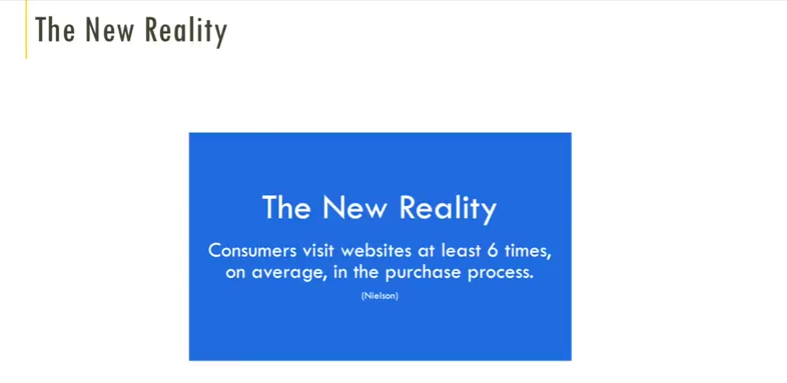
Now let’s say tomorrow, the other 99 come back and two people buy, okay? And then the next day another 97 come back and three people buy. All right, so, what’s my conversion rate? Because I’ve a 100 unique people, and I have 6 conversions, but I have 300 visitors and 6 conversions. So my relative conversion rate is 2%, my absolute visitor or unique visitor conversion rate is 6%.
And so that’s the problem with looking at stats like Average Conversion Rate’s 2 to 4%. Is that from last click visit, which doesn’t look at ‘unique’ visitors, right, versus the ‘all’, which has got the ‘all’ visitors? And so we have this ability to really understand, “Here’s the touch points necessary for somebody to convert today.” So we took a bunch of sites, and this is stats for just one site, and said, “Well, alight, let’s compare 2011 to 2016.” Now, what we want to compare is, how many visits does it take someone to convert. So we looked at… In 2011, it was this site, in particular was 45% of people took one visit to convert.
Now it’s 38% – its a7% drop. So…we will take two visits to convert. I already said that that has dropped. The biggest gains are people who are actually visiting 6, 7, 8, 0 and even like, 12, 14, 15 times, like, to convert. So this means in reality, right, you’ve got people who come to your site initially, most don’t convert. But they do some behaviour on your site. They can start to look at what did you do? You downloaded a white paper, you bounced right off from our site, you added something to your shopping cart and left, you actually checked out, right? What did you do? Because when we think about these two-plus visit people, some of them were like, “You know what? Let’s part ways. You’re on our site for three seconds, you cost us an ad click, we don’t want you any more anyway.”
Others, you’re like, “Wow! You added something to your cart, you even added your credit card into our e-commerce system, and then, your boss walked into your office and then you suddenly closed your browser because you’re buying something at work,” right? Like, “Come back, and you can finish converting.”
And so, we need to start thinking about how we bank these audiences on the Search channel and treat them differently.
So from a PPC practitioner’s stand point, this really means we are kind of thinking of things in sort of two buckets. And we have, okay, people we don’t know anything about, we’ve never had a relationship, we’ve never got an e-mail, they haven’t been to our site, brand-new people, right? And our goal is bring a lot of them in for fairly cheap CPCs. And then we’ve got… we can look at their behaviour, then you say, “Okay, this bucket, we really care about. This bucket we kind of care about.” “This bucket, go away,” alright, and you can essentially start to say how you treat them differently based on those behaviours. And of course, never use words like, “[Some] I qualified your sales staff.” That will start [inaudible 07:58.9] the company, right?
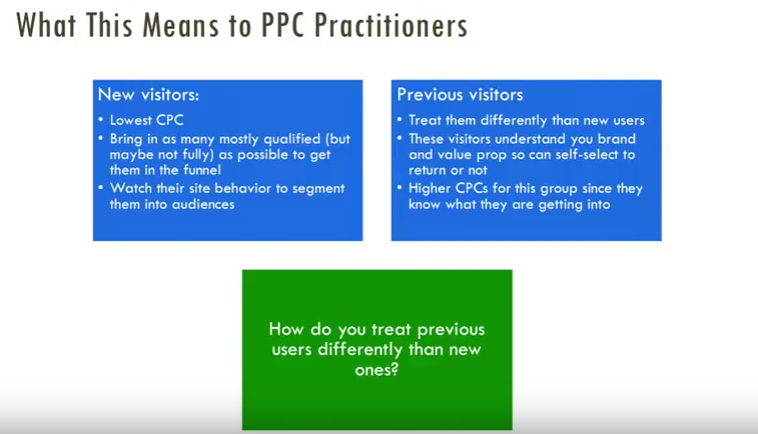
So we’re saying, “Hey, you know what? I’ve got $10 to spend, and I can either spend $10 on the absolute, perfect click to get one conversion, or I could spend $10 on 10 clicks, two of which are going to be click conversions, two of which are going to be decent prospects, two of which are going to be may be six-month prospects and four which never convert,” right? So from a immediacy standpoint, you’d rather spend the $10 on the one absolutely perfect person. From a lifetime standpoint, you’d rather spread it out and say, “How do I treat them differently over time?”
And so, when you talk about any sort of Audience Targeting, how do you treat these people differently? So there is these three different types of Audience Targeting. One is remarketing across display network. My guess is that 95% of you already do this. The most common remarketing is across display. Someone came to your site, they added something to your shopping cart, they left; you make an ad with the product, send it. Well, they came to your site, they, you know, started filling out a form, they left, and then you show remarketing ad – pretty common.
But that’s not commonly used across the Search network. Search network is really, really powerful to combine with the audiences. I’ll show you some stats in a second, how amazing this is, but remarketing is based on website behaviour. So I want you to take a look at these stats for a second. So what this shows is various verticals out there. Now, these are verticals with more than a 100 people using Remarketing Lists for Search Ads. Remarketing for Search compares the remarketing versus non-search data. So we say an ‘automotive’, I would say it’s going to make up 5% of impressions.
So we’re not talking the big expenditure, 5% of impressions. That 5% of impressions is 15% of conversions. It’s a really really valuable 5%. ‘Travel’, the king, queen of needing many visits to convert a user – 6% of impressions, 20% of conversions. So in many ways, this is why you want to treat these people very differently – someone who has not been to your site before versus knows your brand and what they’re getting into coming back; who you are really spending your money on – the 94% that are going to have your typical 2% conversion rate, or that 5% which has an amazing, amazing conversion rate when you bring them back.
And so this is why Audience Targeting really needs to be part of how we think about Search. Now, essentially the longer the customer journey is, the more you need remarketing. So, Payday Loans is gone, but if you look at Payday Loans, you know, you get two hours to get a person to convert, right? There was no, like, shopping cycle for Payday Loans, so it didn’t matter. Remarketing is useless in that case. You’re buying a $5000 three-week cruise vacation package? Probably not an impulse purchase, right? Probably a purchase you’re going to look at and research and look at different places and take three, four, five weeks at least to buy. Look at several places…
So the longer a customer journey is, the more remarketing is really, really important to get into.
Another good stat for remarketing are people who abandoned shopping cart. 75% of people intend to come back and finish the purchase. They just need that reminder, okay? That reminder could be Search, could be Display, could be either place, right? This is that last little nudge. Now we have Customer Match. Customer Match is a very under-talked about feature. It’s like remarketing with your CRM data, through e-mail information you can create audiences from. So if you consider Loyalty Programs, who’s more likely to buy from you? A member of your Loyalty Program or a brand-new visitor? Pretty obvious.
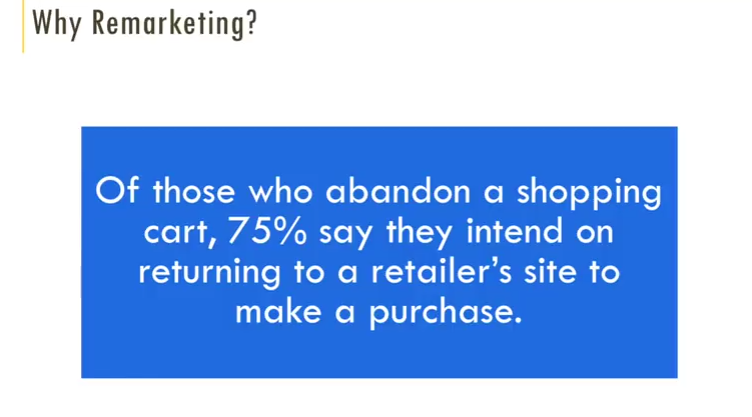
If you’re in Travel, who would you rather spend money on? The business traveller who travels three times a month or someone who’s taking their first vacation in near three years, right? Very different, like who’s got the better lifetime value. And if you’re a TELCO, right, and you offer cable internet and phone, oh, if someone who has cable internet but not phone, you could treat differently than someone who has cable phone but no internet or you can mix and match your buckets.
So if you collect e-mails from users, [calls 12:31.2] probably a great way to do things. Now, one of the advantages of Customer Match is it doesn’t need a user bay in your website. Use offline data. So I could say, “Hey everybody, right? There’s 300 of you here; give me your business cards. And our website’s got good privacy policies, which means I can take your e-mails, I can make a list.” I go to another show, I collect business cards, I can make the list. Now, that list would be “People who attend in-person shows.” Now, I can then take another list and say, “People who visited webinars online,” right, and I can make a list out of that. And then I can say, “Where’s the cross over?” because they just really want information, now look at the media.
So now, we could take that information and say, “Alright, these individuals who like to come to conferences, we’re going to market them differently than people who want to watch the phone line differently than people who just want to get access to content.” You can segment out that same user who just wants to learn and get content. But then that’s the advantage of Customer Match, is it could be data from a lot of different sources including offline [CRM] information.
Then look at which one to use? A Customer Match is good for re-engagement or offline data, where remarketing is better for that ‘recency’ effect. If someone’s been to your site within three or four days, or even a month in time, remarketing is great. But if you have, say, a year over year buy, well, remarketing is the last line because cookies expire after six months. So if you’ve got maybe seasonal, may be you sell ‘Thanksgiving Turkeys’, right, and you have a one amazing day every year, well, remarketing is useless, right? I mean, they’re not going to buy a turkey every week. But, every year, right before Thanksgiving, you could use that exact same user base again, show them ads, “Here is that seasonal buy time.”
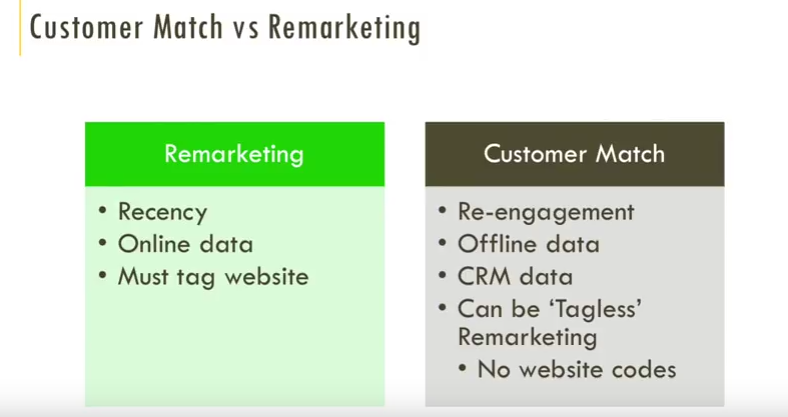
So we also have DSAs, and this is not an Audience, so I’m going to come back to the Audience later. So DSAs or Dynamic Search Ads allow you to leverage organic call technology, to automatically pick keywords off for your site and expand reach. Kind of scary , sounds like lot of people at Google sort of pick your keywords. When you come out with Audiences, that can be really, really useful. So we’re thinking about the targeting options for audiences, well, you’ve got RLSA which is remarketing across Search networks, and your Customer Match which is CRM data. Then Display Remarketing, you can use DSAs as sort of a feature of these.
So when you think of what can you do with this? “Okay, fine, we have the audiences. What can I do with this audience data?” Well, the most common thing you can do is to change your bids, right, and say, “Hey, you came on our site, you added stuff to your shopping cart, you didn’t buy. We’re willing to bid more to have you come back to us versus the competitor.” Most common reason people start using remarketing.
Now, when most people look at remarketing and they say, “So you’re suggesting I increase my bids again,” right, because you usually talk to Google, and what’s the answer? “Raise bids, raise budget,” right? That’s usually, what honestly every answer is, right? It’s one of the two. Or like, since…. like the first time I looked at this, right, a few years ago, I’m like, “So you’re saying I should start with a 100% higher bid, I should double my bid to start. Are you kidding me?” And I’m like, “This is no way.”
Then I start looking at the data and say, “Wow, it’s 6% of impressions, 20% of conversions.” The data says in many cases I can actually triple my bid. That’s a really scary place to start. There are good ways of just starting with Google Call Reporting mode, right? Add the Audience data to your account, do bid adjustments. So now, you start getting information that shows you,”Hey, this audience actually converts worse, you want to lower your bid”; “This audience converts better; you can raise your bid.” So you don’t have to jump right into this. You can actually create audiences, add them, what is the click data, and then make decisions from there.
Now modifiers can be negative too, right? So we’re an Adobe country here, so we think of someone who’s an Adobe subscriber, right? Well, Adobe has got a lot of products and what they probably hate a whole lot is someone searching for Photoshop log in, Omniture log in and clicking on an ad to log into their product, right? That’s a terrible click. That person’s not going to convert. So you can make a negative list as well and say, “Okay, you’ve logged into our system in the past six months. So if you search word ‘Log In’, we’re not going to show you an ad; you could just click on the organic link and go log in again, alright? Stop clicking our ads to log in.”
But again, you’ve been to a lot of cross-sell opportunities. So you might say, “Well, they searched for another product for your offer that plugs into what they have. We actually should show them an ad, as a nice cross-sell [bundled item].” So you can go ahead and change, up or down in your bids for what you are doing. So we just add this to get reports, we just get stats and say, “We’re not changing our bids, not raising our bids. Well, we can see how this works against our regular based ads,” right? So it’s a good way to sort of just get some information first before you do anything.
Now another thing you can do with it, you can change the ads. You could say, “Well, if you’re in this audience and you do this search, we actually want to show you a completely different ad to a user.” I would say if someone is a member of your Loyalty Program, your ad can put in there, “10% Discount for Card Members, for Loyalty Members.” If you’re trying to cross-sell, you can put in there, “Hey, you know, For TV Subscribers, Phone is 10% Less,” right? So you can actually add custom ads based on the information you know about the user. Now it’s custom to an audience bucket, not the individual user. You can change the ads around.
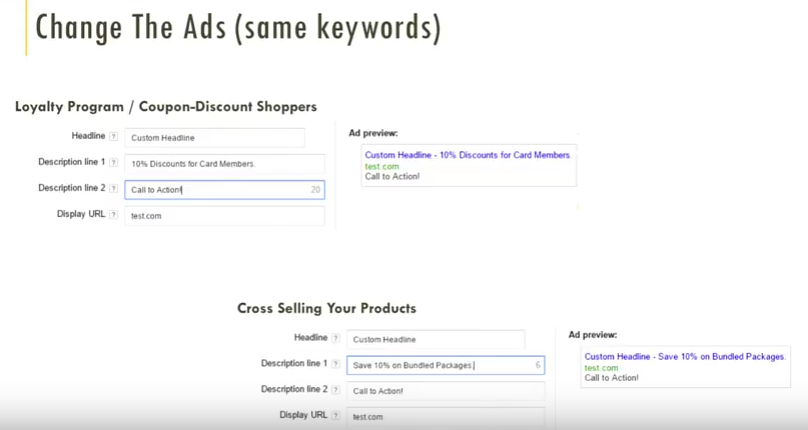
Common way is along sales funnels. Think of a long B2B sales funnel here. Someone comes to your site. First goal is going to be download a white paper; then you want, you go ahead and have them do a product demo, then start a free trial to make them a customer. So essentially, you have an order you want people to do things in. You could say, “Okay, for the group that has downloaded a whitepaper, we now have started a demo,” or add same keywords, right, just say, “Hey, go try free demo.” Someone is in a demo; they haven’t actually started a trial, right? You could say, “Okay, you’ve done this; this is your next step,” and you can walk users through a long sales funnel by using Audience Targeting, switching the ads around based on where they currently are in the sales funnel.
Expand keywords. So, I live in DC. And, for a get-away, DC is the worst commuting traffic in the entire country. It’s amazing, amazing. LA, New York…? No, it’s DC. Fact of the point that DC has interstates that you must have two to three people in the car even to drive on it at certain times of the day. Like, it’s not just hub. You’re not allowed on the road without two people unless you’re in a Leaf, you are in a certain years of pre-assess, you’re in a test, or some sort of electric car. The value of electric cars is huge because they let you actually break some of the hub rules in the area.
Now, what this means though, is that there are a certain people who came to your site on a word like “Chevy Volt,” “Toyota Prius” that they’re going to buy something. And then, you’ve got words like “Hybrid Cars,” but “Hybrid Cars” have kind of fallen out of vogue these days. So, ‘Auto Search Volume’, no Ads in the entire DC area on that term. So you could say, “Well, if you came to our site on the term ‘Chevy Volt’, and you just searched for a ;Hybrid Car’, ‘New cars’, anything, right, we know this about you, we should show you an ad to get you back in to actually schedule our dealership,” right?
And so, that’s a great way of using Audiences to say, “We know you showed an interest in ‘X’. If you search for anything around ‘X’, we should show you an ad again; I wish to get you back in that funnel.” And so you could use different keywords, you can use different match types. If you have keywords that you bought in the past or too expensive and that will be useful only if someone did an audience; so there’s a lot of ways to use that.
So if you want, so, like, keyword expansion, you might have, “Here’s our set of keywords we can afford; they are predictable. Anyone can see these.” And, “Hey, here’s some broad match words, actually some broad match. It has some uses,” right, plus an audience because the audience number is pre-qualified.
We know what they did; we know they did ‘X’ on our site, and that we’re willing to get them back if they search for something even ancillary to what we do. This is also great with Dynamic Search Ads. So, DSAs leverage organic call technology and basically say if the Search Query matches something on your site, then show an ad. But it has a lot of good uses – e-commerce, backfill information, lot of good uses to it. But if you want to…for initial foray into DSAs, great way to do it is, “Okay, you were on our site, may be you even bought from us before.” Treat customers differently. “So if you bought from us before, and you searched for anything across our product suite, hey, let’s use DSAs; let’s put these two together, so that anyone who’s bought before who searches for anything on our site can see an ad automatically.” So it’s sort of automatic keyword expansion only for specific groups.
So with Audience Targeting you can change bids, change ads, you can change or expand your keywords. So when you think about where this starts, it all starts with website segmentation or CRM data segmentation; all sorts of segmenting information first. So the general rule though is when the list becomes so astronomical you don’t know what to do with it, you shouldn’t be segmenting that far, right? So if you think of a simple e-commerce site, you’ve got ‘Logo’, you’ve got ‘Napkins’,’ you have ‘Plates’, you have ‘Logo Napkins’, you have ‘Logo Plates’. Okay fine, that’s four lists. And then ‘Abandoned Shopping Cart’ and ‘Checked Out Users’, right? So, six lists.
And then if we go down to Category, we went from 4 lists to 32 lists; that sounds scary. If we go to one more category, you go from 32 lists to 257, alright? No human wants to solve a 257 lists. So, let’s just start with a few, right? It’s fine to start sort of smaller, get the data, instead of starting with everything possible. Now, it’s easier to talk about the segmentation with non-e-commerce, or e-commerce, rather. Non-e-commerce is the same thing. Everyone, every single site flow the same: ‘Home page’, your’Category Pages’, your ‘Product Pages’, your ‘Check Out’. ‘Check Out’ could be a phone call, it could be a form fill, it could be an e-commerce traditional checkout, all the sites flow the same way.
So even if you are a remodelling company, right, you got, “Hey, someone wants your Home Page, someone who said ‘Remodelling versus Room addition’, someone who said ‘Bathroom remodelling’, there we go, that’s what they want,” alright? So everyone’s got that same sort of flow regardless of e-commerce or not. Now there are sometimes some cool things you can intuit with this. So this is “Uncommon goods,” you can see the same thing, Etsy and so forth; they have a really good shop four types of categories. So when you look at a site like this, say, “Okay, what can that really give us?” We know who uses ‘Shop for Men’ category, ‘Women’; who uses ‘Shop for Women’ category; ‘Men’.
So you actually can start making lists; it’s not perfect, but it’s say about a demographic insight. Now you know who buys the most baby goods – women. So you can make a list that says, “Hey, if you entered the ‘Shop for Men’ category, you’re probably female. I mean, not a 100%, but you’re probably female, which means if you then search one of our ‘Baby Good’ items that we have, we should raise our bid because you’re a female who converts better than male to begin with.”
So there are other types of segments you can do that sort of gives you sort of insights into things beyond just an audience, but it could be demographic, it could be age-based and so forth.
Now, thinking of CRM. CRM’s the most difficult one to get into because every CRM system is different, right? Do you really have one list? Can you segment your user data? What can you do in your CRM information, right? I mean….so this really depends a lot on how you collected and the technology used for your CRM data. But you’ve got, you know, loyalty users, non-engaged users, people who bought a certain product, users who buy a lot but really low margin items, who buy very little but they’re really big items when they do buy; someone who went to a trade show versus attended webinars versus demos. So really, with CRM, there’s no fast rule of how you segment.
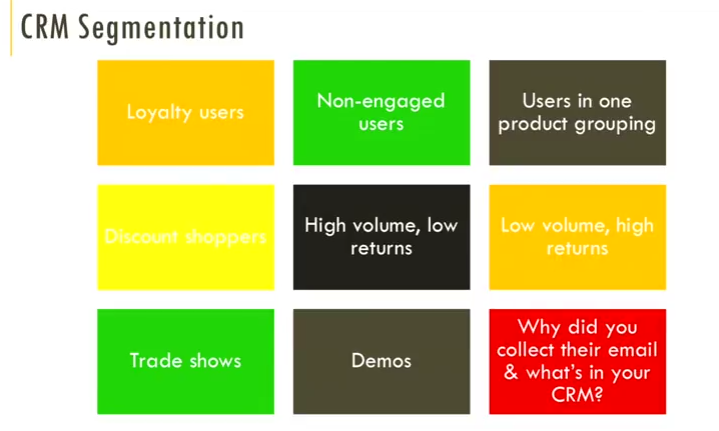
Ask yourself, why did you click that e-mail? You have a discount section on your ‘Sign-up for Discount.’ Well, that’s really very different than someone who bought your most expensive product, right? Discount shoppers, expensive, very different types of people. So the more you can segment your CRM data, great, but it’s hard to give good roles for CRM segmentation because there are so many different types of technologies out there for it. So, well, let’s look at how this sort of works together then. So this is just a simple, ubiquitous flower example.
So, first holiday of the year, Valentine’s Day, as far as flowers go. Sorry, you searched for “Valentine’s Day Flowers”. Simple question: Did you buy, right? Yes? Put them in that “Holiday Buyer” list. No? Put them into “Shopper” list. Pretty simple, show remarketing ads. Alright, second holiday – Mother’s Day is about six weeks later, alright? So simply you [inaudible 26:23.7], “Are you in our ‘Shopper’ or ‘Buyer’ list?” If, ‘Yes’, raise the bids more likely to buy again, since you know the company. No? Don’t raise the bids. Same ad, reaching the audiences with a bid modifier. “Did you buy?” Put them in the ‘Buyer’ list. No? Put them in the ‘Shopper’ list.
Now, in theory in flowers, the third holiday of the year is almost always an ‘Anniversary’ or a ‘Birthday’, non-predictable event time, right? It’s not until you get into Easter or Thanksgiving and Christmas you see more. So you could say, “Okay, we don’t really know when you’re going to buy again. Oh, we know you bought once or twice, it’s not going to… how likely you are to buy from us.” So then you’ve got the next, like, could be ‘Mother’s Day’ next year, could be the next ‘Anniversary’ or ‘Birthday’ time, right? Your list now becomes ‘people who bought from you in the holidays’ or your ‘CRM data’. “Hey, if you bought from us last year, then want to show you an ad again this year, and sort of repeat,” right, how people are going to engage with you.
And when you have that year over year seasonality, remarketing fails, right? Because your cookies expire, people switch phones, computers, what not, right? Custom match is better. So really useful start to think about: How do people buy once, then twice, then three times, and then over time? So it’s a sort of set that plan up, you know, year over year over year. Now, in other places like SaaS, it’s different, right? SaaS is about churn versus sales.
So you may treat new customers differently than you treat your every-year customers. Now here is a much more complex example of what’s possible. So it’s a large SaaS company, it’s not Adobe, different company. They have ten plus car products, so big, big SaaS company. Can you say what are the lists? Oh, they have one list that’s for their blog, right? This is by content application. In fact they treat people who read their blog versus actually do share as differently.
Because if you want to amplify content, they’ll say, “Hey, this person actually shares our stuff on Twitter a lot. Let’s treat them differently than someone who just read our blog.” Now you’ve got everyone who came to this site. Now they sort the segment into ‘SMB’ versus ‘Enterprise‘ common segmentation. Then they say, “All right, did you download a white paper?” Now they actually have this ten different times for all their products. Whether are you ‘SMB’ versus ‘Enterprise’, you have a white paper download. And then you’ve got… Can you put that back up? I can remember all this top of my head.
Then you’ve got people who started a free trial, right? Different group. ‘People who are customers less than 60 days’, ‘people who are customers more than 60 days’, ‘current employees’ – you break 20 or 30 thousand employees, they can really mess up your ad spend, right? Then we say ‘TV Commercial Lists’. We actually look at “When did a TV commercial air?” and then based on the geographics of it airing, did you come to the site within zero minutes to 30 minutes of the TV commercial airing? So the media for the remarketing can actually match in the commercial.
There’s a lot more. Now you think, “Okay, what do you use this for?” Well, number one, ‘Employees’ are a negative list; they found their employees kept searching their [help] files and clicking on their ads. They saved a whole lot of money making ‘Employees’ negative lists using your CRM data; easy way of just not even remarketing. Just use your CRM data, upload your ‘Employees’ email list, boom, done.
Blog readers – Well, let’s use Remarketing lists for Search Ads plus DSAs. That way we can kind of automate the fact that our blog is well read, well shared, but having to pick keywords for a blog – that’s what’s really annoying. And for a site visit, bid modifiers, right? And let’s start raising this, and let’s do a little bit for ‘SMB’, a whole lot for ‘Enterprise’ because it’s been always a whole lot more ‘SMBs’ than ‘Enterprise’ , and ‘Enterprise’ will be white whales in many cases. So, “Did you download our whitepaper? Ah, you started getting into conversions. Now they want to treat you really differently.”
So let’s expand at the keywords for this group. So actually start using some broader keywords in different match types. And then, let’s actually change the focus of the ads in this group to have them start a ‘Free Trial’, because they actually started the conversion process, say, “Did you get a ‘Free Trial’? Alright, excellent” So now the ads more are focussed on getting them from a ‘Free Trial’ to a ‘Paid Subscriber’, so also focus on getting them to log in and try a trial. In SaaS, your biggest problem is someone starts a trial but 20 seconds later, may be a minute later, they’ve either left forever or they’re really into the product, right?
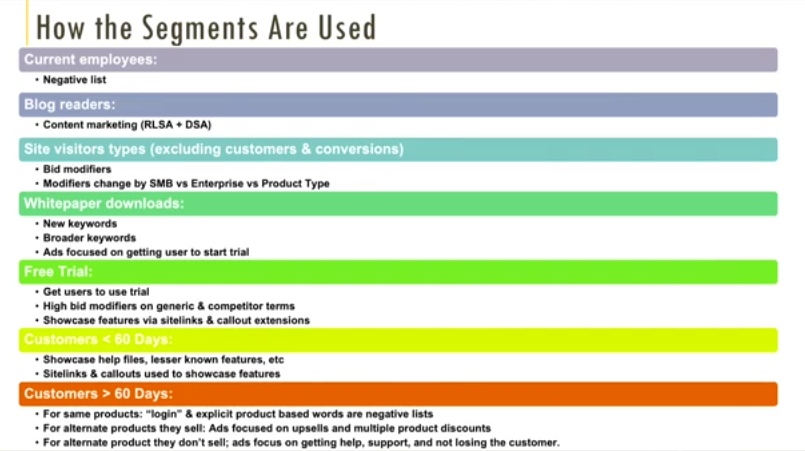
So what is that second or third touch point to get them back in, “Hey, you have a ‘Free Trial’ Actually log in and use this.” And actually it’s a different campaign, so that way they cannot use Sitelinks and Callouts saying how, “Here’s all the other features you probably don’t know about the product.” Then if you’re a customer less than 60 days, right? You’re still a new customer, good chance of losing a customer at that point in time. So now, they want to showcase, “Here’s Help files, here’s Demos, here’s other ways of using the product.” There is a whole stuff you can do with that, right? How many hooks can they get into you?
And then, customers over 60 days, now it’s like, login and making a negative list, but let’s look at all the cross-sells we can do and make those positive lists that sell back in your own product set. Yeah, this is a lot, right? This is one of the things that if you want to get into this much, this is what’s possible; it’s a lot of data. Be prepared to either really manage this much or start slow, right? Find a start slow and move from that.
This is as simple as it can be, right? So this is that company we started with early on, small e-commerce site. I’ve been working on their site for now 14 years, 15 years, another__ Their account, not even looking at it these days, alright? Then, “Fine”, like, “Alright, I will give in. Now we can do some Audience Targeting.: You know the client type and it takes you forever to get them do something pretty simple. So right now, this is a company they think of like a [Leeds]. So they do custom products and custom products for businesses are different than for consumers.
For businesses, they buy more often and they have higher Average Order Check out values. For consumers, you know, some people really do want to buy 50 plates with their kids’ picture on it for their birthday party, right? But they don’t buy this very often. This is a very unique type of thing. It’s a very low average order value. So you want to treat these users differently. So, alright, so this is going into GA and making three audience lists. And that takes about five minutes to say, “Everybody”; “People who checked out more than $500”; “People who checked out less than $500.” Just follow five minutes of work in GA.
Exporting, uploading CRM data took a little bit longer just because your CRM system, like many, is a little archaic and hard to work with. So that’s one of those, like, ‘How do we get B2B versus B2C buyers?” which is ‘Shipping Address’ information, and it would take about 10 minutes. Or creating Display Remarketing campaign, and that’s creating great campaign name; they are already a merchant, so they have ‘Merchant Feed’; add ‘Merchant Feed’ and that’s whole minute of work.
Making a dynamic image ad – so now with the html5 responsive design ads, you create a couple of lines, you add an image, you got to play that branding a little big, this and that, so that takes about 15 minutes; it’s actually the hardest part, by playing with all responsive images. Making a DSA campaign – well, that takes two minutes to say, “Create new campaign hype for your DSAs,” right, and then adding all list to ad groups. If you do this, do it in the Editors, not the Interface. It’s so much fast in the Editor. You say, ‘Copy my list’, ‘Select all my campaigns’, ‘Paste my list’, ‘Paste them everywhere.’
If you don’t do bid modifiers, you don’t affect anything, you’re just not getting stats. So this is 44 minutes of work. We talked about 44 minutes, right? They had RLSA set up, they had Customer Match set up, they had Expanded Keywords set up, and they had Display Remarketing set up – 44 minutes of work. This is what it led to, right? RLSA is 12% increase in conversions, 9% revenue.
Customer Match, because they could reach B2B better, right? That’s often a hard thing, if trying to reach B2B versus B2C, they can reach B2B better with Customer Match – 11% increase in revenue. Display Remarketing 6% – this is month over month over month, alright, and this is not super complicated, right? This is more of saying, “Did you come to our site and not bounce off right away? Did you buy something from us? If you bought something from us, do we ship it to a business address or residential address?” And it’s three pretty simple questions, right, and then saying, “How do we leverage this within our Paid Search Accounts?” right?
And they actually use RLSAs for Bing as well. Bing has RLSAs, by the way; they don’t have Display Remarketing, but they do have RLSA, so you can do it in either one, right? And so, this is what a lot of it really comes down to, is ask yourself, “How do you treat people who do certain behaviours on your site differently?” So someone came to your site, they now know your offer. For good or bad, right, you’ve made the hand shake, you did the introduction, they like you, they don’t, alright? So they made the initial connection. So some people are going to look at your ads and like, “Never going back there again.” Oh, well, alright, that’s…we’re going to lose some of them, who made the impression. Others, when they look at the ad, they know who you are now.
So, like, “Okay, I actually want to come back to their site again.” But again, you’ve got to make sure that they see you; that you’re visible when they’re looking for something, so they have that easy avenue, right, to come back to your site once again. Then you’re saying, “What’s the value of these different visitors?” I mean, it’s pretty obvious when you think about it. Someone who came to your site, spent one minute; someone who added something to the cart, left; someone who added something to the cart, added their credit card to your site and left before they finished clicking the “Buy” button.
Pretty obvious which one of those is more valuable than the other one, right? That..a lot of this is pretty intuitive, does not require a whole lot of math to figure the initial parts of this, right? Ask some basic questions, make some audience lists. I believe that the Fortune 500s, it’s something like 90% have an RLSA list; I believe that less than 1% have applied it to most of their ad groups, so it’s one of those. Now you will have started down this path, and very few people have gone far down the pathway, right? And that’s again where there’s a whole lot that’s available, when you start thinking about your group really in different audiences.
So when you start, think about, you know, audiences are no longer just social; they’re no longer TV; audiences are a word that should be part of Search marketing now, right? You’ve got RLSA, Customer match, Display Remarketing. All three have different uses, all three are useful to use at the same time in an account. You can change your bids up or down, right? You can [inaudible 37:41.7] audiences, you can change your keywords, expand keywords, and change your ads.
But audiences, this is a small percentage of traffic, right? This is not 80% of your traffic, right? And when you have global impressions for paid search, 4% to 10% of them; small percent of impressions – that 4% to 10% impressions can make up 15 to 25% of your conversions so they’re the really valuable part of your impressions. Lower CPAs, they know what they’re getting into. And so when you think about Search these days, average customer, 6 touch points, 2 converts. Let’s say average is 6. Now, of course, some slides are 1, some slides are 20, right? Average is 6.
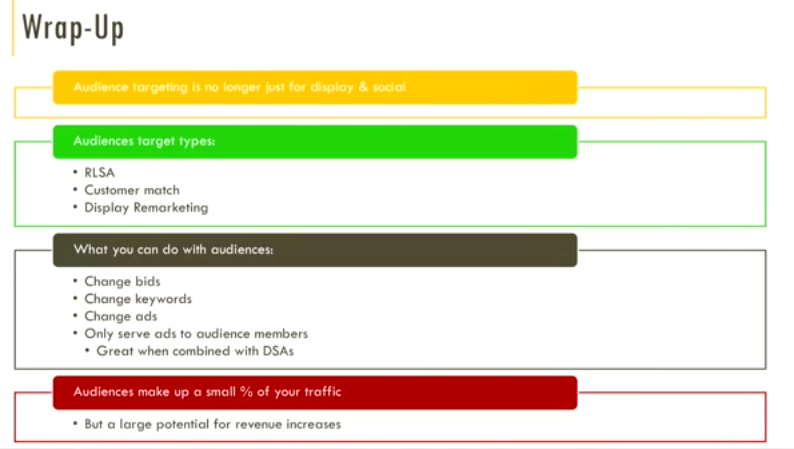
So the first one, “Hey, it could be from social, it could be from a blog post, it could be from Twitter, it could be from a business card, it could be from Bing or AdWord,” right? First one’s there. Got to get the first one and just say, “Okay, based on these first ones, how do we treat the rest of these differently?” And then that’s where the audience starts kicking in, is when you start treating people who do certain behaviours – download the white papers, spending more than 30 seconds in your site, calling your company, right, treating them differently. And that’s when Audience Targeting really, really starts coming into play.
And, of course, I’m a marketers just like you are, and you know what the first rule of conversions is? ‘Ask for conversion’ – first rule. But the best ROI you can get, got to sign outside your business, right? So, real quick, we’re an Ad Testing Insights platform, you want easy clicks, simple ways of testing ads, getting N-Gram data, see [inaudible 39:26.1] your N-Gram data is… Getting cool insights, take a look for a Free Trial too! Alright, thank you.





Stop the wasted ad spend. Get more conversions from the same ad budget.
Our customers save over $16 Million per year on Google and Amazon Ads.